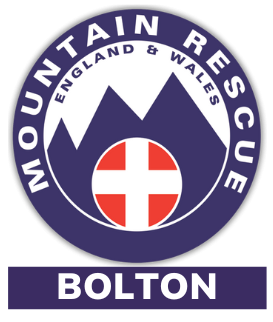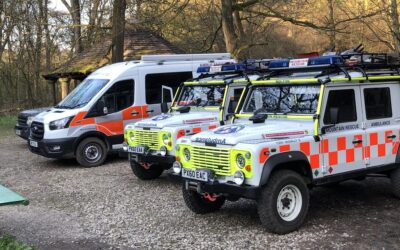Being in a voluntary Search and Rescue organisation dealing with the incidents we generally deal with, there is some pattern to the time one can expect a call out and a time when one can generally expect to relax.
Now its not totally uncommon but as a general rule we do not get calls at 00.39 hours in the morning to “a report of an injured male on a ledge on a rock face.” but that’s what we got this morning when the pagers went off at 00.39 with the message “PLS contact GMAS Paramedic Control.” An emergency caller had stated that he was camping with a group of other youths and that one had had an accident, falling over a rock face and landing on a ledge. In response to this Paramedic Emergency Control immediately paged the team as well as obviously despatching an Ambulance.
When our Team Leader Garry Rhodes responded to the pager from GMAS requesting more information it was quickly established that the actual incident site / location was not known, nor was the 999 caller able to fully describe the actual location, other than on the edge of fields and trees overlooking Horwich.
In close liaison with GMAS Control our Team Leader firstly mobilised the team, then tried to jointly determine with GMAS PEC, utilising his expert local knowledge, where the accident location could be.
An initial RVP was established in Horwich town centre, where our Team Leader, Deputy Leader (who besides living in the area also has considerable expert local knowledge) and responding team vehicles and members met up with the responding GMAS Emergency Ambulance.
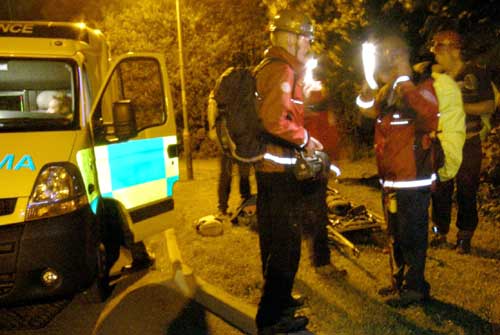
Bolton MRT Members arriving at the Ambulance RVP.
GMAS PEC had meanwhile maintained a dialogue with an informant at the actual casualty site but could still not determine the location with any degree of accuracy. Our Team Leader then spoke to the informant and it became established that the accident was somewhere in the moorland ravine of the River Douglas valley on the Horwich / Rivington boundary. (more familiarly known as Tigers Clough, a site well known to us from both previous incidents and exercises).
Carefully establishing which side of the valley to respond to took further time, with all the responding vehicles relocating to the top of Green Lane alongside Tigers Clough at 01.30 hrs, again in full liaison with GMAS PEC.
Our Deputy Leader led by a youth who met him at the roadside RVP at Green Lane and knew of the actual incident site, then went up the steeply sided and densely wooded clough to locate the incident site and guide in the rest of the team.
Our Deputy Leader, Geoff Seddon, came across a group of youths who had been camping out overnight in the clough, one of whom had fallen over a vertical 5m high rock face, landing in the stream bottom, which fortunately was relatively dry and also clear of any rocks or boulders that might have caused further injury.
The youths were tending to their injured companion having followed the advice passed to them over their mobile phone(s) by GMAS PEC. Geoff Seddon carried out an initial casualty assessment and discovered that the youth may have been unconscious for a short while immediately following his fall and was complaining generally of pain and bruising, with a possible head wound(s). The main Bolton MRT rescue party was quickly despatched with a stretcher and various casualty care equipment to the site up the valley, arriving on scene at about 01.50 hrs.
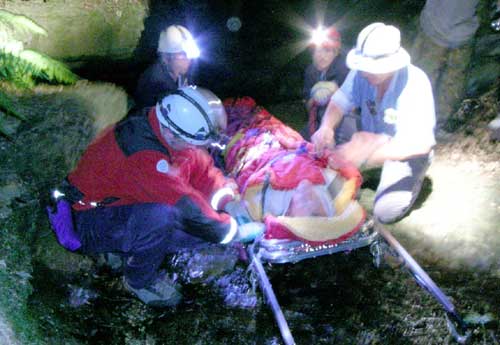
Bolton MRT Members with DTL Geoff Seddon (right) prepare to move the casualty on the Bell MR Stretcher.
The location was quite tricky to work in due to the slimy and slippy nature of the stream bed, with a very loose rock face directly next to where the casualty, a 26 year old male, was laying. He was also very wet from the water in the base of the stream which due to recent warm weather was fortunately merely a trickle.
The male was placed on our Bell Mountain Rescue Stretcher, and then stretcher evacuated downstream out of the valley.
Being night and dark (despite our powerful head torches and hand held search lights) the evacuation was quite tricky, with steep drops, very narrow paths (eight team members usually jointly carry this type of stretcher at the same time) and overhanging low tree branches all conspiring to thwart an easy stretcher carry.
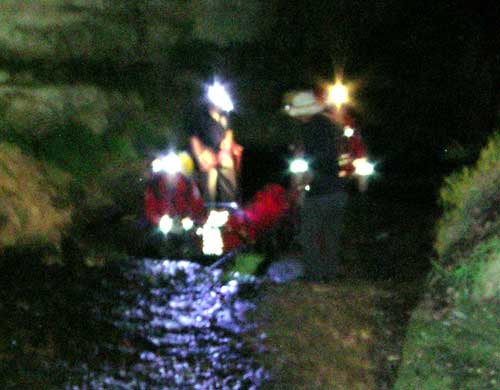
Bolton MRT Members carrying the stretcher along the stream bed.
By 02.26 the casualty was back at the roadside where the responding GMAS crew then took over casualty care, departing for Royal Bolton Hospital at 02.50 hrs.
We were then faced with packing up all our kit used in the rescue operation and then for one of our vehicles a trip to Royal Bolton Hospital to collect team equipment which had gone with the casualty to hospital in the Ambulance. (our Long board and head blocks)
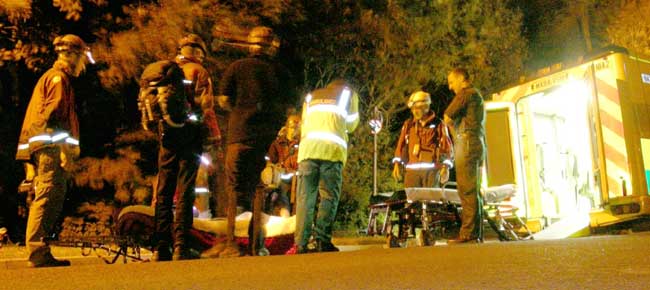
Casualty arrives with the GMAS Ambulance for the hand-over.
By 03.30 in the morning we were back to our homes to catch up on some sleep first interrupted for some at 00.39 hrs when this all started. In all, four team vehicles responded and fourteen team members, with all but one who stayed at the roadside as road head control, being involved in the stretcher carry.
An interesting little rescue operation, and one that could not have happened without the excellent liaison we have with GMAS PEC and their responding Emergency Ambulance crews.
